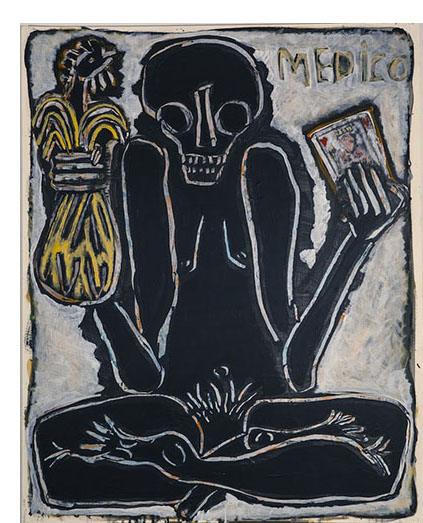|
Art Review
Yisrael K. Feldsott @b.sakata garo
By David Roth, Squarecylinder
 |
"Medico, 2013, mixed media on paper, 45 1/2x 37 1/2"
|
| |
|
Yisrael K. Feldsott’s Neo-Expressionist paintings appeal to our collective conscience.
Depicting war from the victims’ perspective, they show tribal and native people under
siege, surrounded by symbols that suggest conflicts around the globe: in Latin America,
the Middle East and Africa. While violence of the sort Feldscott describes is pervasive,
its psychological toll can be difficult to gauge, particularly since most of it comes to us
through media images.
Feldscott brings these conflicts into sharp focus with a point-blank perspective.
His paintings on paper and panel (which carry titles like Soldier with Collateral Damage,
Crack in the World, Path of Sorrows, Death Beds, Border Crossings, Law and Order and Burning Monk)
are packed with skulls, automatic weapons and cowering figures flanked by repeating decorative patterns,
animal forms and other bits of tribal
iconography. He weaves them together using confident, impassioned gestures and with tropical
colors set against dark grounds. They are haunting, electrically charged and utterly convincing.
So much so that you may wonder if the artist witnessed the events he depicts. While nothing I’ve read
confirms this, other parts of his biography suggest that possibility while also pointing to alternate ways
of seeing and knowing.
The first was growing up in Chicago. There, Feldsott absorbed the influences of Jim Nutt, Karl Wirsum
and Leon Golub and other so-called “Imagists” who refashioned the darker impulses of Surrealism and Dadaism
into a grotesquerie that, for a spell, became the city’s trademark. He then moved to San Francisco, where
in 1974 he became, at age 21, the youngest artist to exhibit at SFMOMA. The work was a scruffy, scratchy,
graffiti-like mix of feral beasts and shot-through figures overlaid with stenciled
text. It placed him slightly ahead of the wave of Neo-Expressionism that would later sweep New York.
But instead of riding it, Feldsott dropped out. In the late 1970s he traveled to Mexico, Central
America and the Amazon jungle where he studied shamanism before returning to Bolinas where he now lives
and works. During his absence he kept painting; but for two decades starting in 1979 he stopped showing.
He resurfaced locally in 2008 in a show at the Paul Mahder Gallery that caught the eye of Peter Selz, who,
operating under the auspices of a curatorial organization called Rediscovered Masters, became Feldscott’s advocate.
A survey of the artist’s history, gleaned from exhibition catalogs, shows close affinities
to Jean Michel Basquait, Keith Haring, Sue Coe and Raymond Saunders. We also learn from these
sources that he is a practitioner “psychotropic therapy,” which, if I recall Carlos Castaneda
correctly, entails the ingestion of ayahuasca, a powerful hallucinogen that can just as easily
shred the mind as open it to startling visions. Which may explain how Feldscott is able to credibly
channel the horror of war without actually experiencing it.
Problem is, the visions Feldscott summons seem to be filtered through the sensibilities of artists
who preceded him, particularly the German Expressionist A. R. Penck, whose totemic, pictographic forms
strongly resemble those seen in Feldscott’s work. Picasso also comes to mind, particularly in the mask-like
faces that populate many of Fedscott’s paintings. While he executes them masterfully and with tremendous depth of
feeling, it’s hard to see past the references they so obviously call forth — even as they carve a pipeline into the
spirit world, tapping what feel like the
same impulses that drove humans to draw on cave walls.
Yisrael K. Feldsott WHERE: b. sakata garo, 923 20th St. WHEN: Noon to 6 p.m. Tuesdays-Saturdays,through May 30 INFORMATION: (916) 447-4276
|
